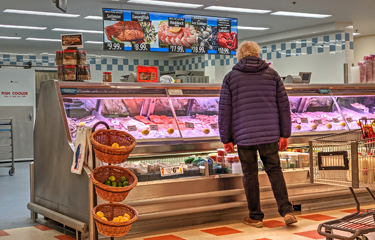A new survey of U.S. consumers is showing some pushback on the recent increase in seafood prices.
Food prices continue to rise across most categories, according to the U.S. Bureau of Labor Statistics’ Consumer Price Index and several recent consumer surveys. The U.S. consumer price index soared 5.4 percent in July 2021, compared to July 2020, and 95 percent of consumers noticed an increase in retail prices over the past month, according to data firm Numerator.
If prices continue to rise, 23 percent of consumers say they will cut back on purchases of seafood, meat, and poultry, Numerator’s “quick-pulse” survey found. Plus, 23 percent will reduce purchases of certified sustainable products and 46 percent will cut back on organic or premium items.
Fresh, frozen and shelf-stable seafood prices have all shot up in the second quarter of 2021, according to recent data from IRI and 210 Analytics. Frozen seafood prices experienced the biggest gain in the second quarter of this year – up 9.2 percent versus the same quarter in 2019 to USD 6.96 (EUR 5.95) per pound on average in U.S. grocery stores and mass retailers, according to IRI and 210 Analytics.
Fresh seafood prices also soared 8 percent in the second quarter of 2021 versus Q2 2019 and 4.1 percent versus the Q2 2020 to reach USD 8.40 (EUR 7.14) per pound on average. Shelf-stable seafood prices rose 4.4 percent in the second quarter of 2021 versus Q2 2019, but fell 0.3 percent compared to Q2 2020. The average price for the second quarter of this year was USD 4.88 (EUR 4.15) per pound.
However, other food categories will take a much bigger hit as consumers continue to see rising food costs, according to Numerator. If the high prices persist, 54 percent of shoppers said they will cut back on desserts and candy and around 47 percent will cut back on prepared foods and deli items. Around 45 percent will reduce purchases of soda, 31 percent will cut down on alcohol purchases, and 13 percent will reduce purchases of fresh produce.
Consumers are “absolutely aware” of the widespread inflation in both retail and restaurants, 210 Analytics Principal Anne-Marie Roerink told SeafoodSource. “Food or nonfood, produce, seafood or snacks – consumers are paying substantially more today than they did pre-pandemic,” Reorink said. “Additionally, there have been fewer promotions throughout the store.”
However, because Americans are more focused on making healthful choices, seafood’s “health halo will be an important counterbalance to the inflation seen thus far in 2021,” Roerink said.
In addition, seafood shoppers tend to be wealthier, with greater disposable income that helps them feel less impact during periods of higher inflation, according to Roerink.
Seafood sales may be further salvaged due to changed consumer habits caused by the COVID-19 pandemic. The past 18 months have taught consumers that cooking at home is substantially cheaper than eating out, Roerink said.
“In addition to more meals prepared at home, period, we’ve seen this result in premiumization of purchases across the store – including seafood – with great strength for items that are more indulgent in nature, from premium chocolate to crab legs,” Roerink said. “The question is, how much more prices will rise across categories, elevating the entire purchase far above 2019 levels. More people will take more money-saving steps the longer inflationary conditions hold or grow. But for the time being, seafood sales seem to be extremely strong.”
The seafood industry might also benefit from another trend accelerated by the COVID-19 pandemic – e-commerce. Research firm Acosta recently found that around 45 percent of U.S. consumers have increased their online grocery shopping and reduced trips to traditional consumer products goods channels since pre-pandemic.
“While many believe we’re headed towards normalcy, it is highly likely that certain pandemic-related shopping habits, particularly consumers’ reliance on e-commerce, are here to stay,” Acosta Executive Vice President of Business Intelligence Colin Stewart said in a press release. “Shoppers have become accustomed to ordering groceries online or through subscription services, with contact-free pickup or delivery options. As we move into a new phase of the pandemic, these grocery shopping channels will remain significant, as will consumers’ increasing focus on product availability, low prices, and promotions, whether they are shopping in-store or online.”
While the U.S. online ship-to-home grocery sales dropped by USD 1.4 billion (EUR 1.2 billion) in July, compared to July 2020, according to the Brick Meets Click/Mercatus Grocery Shopping Survey, the combined pick-up/delivery segment remained steady at USD 5.3 billion (EUR 4.5 billion) for the third straight month, according to the research firm.
“The July results clearly reinforce that online shopping has maintained a significant portion of last year’s gains, especially for pick-up and delivery, but the surge in new COVID-19 cases during July appears to have impacted shoppers’ buying behaviors differently than at the onset of this crisis in 2020,” Brick Meets Click Partner and Research Lead David Bishop said in a press release.
Photo courtesy of QualityHD/Shutterstock







